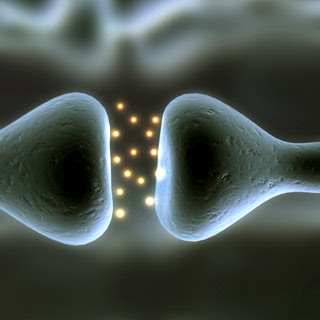LRR proteins help neurons find a partner

Matching 100 billion neurons with their appropriate partners is a daunting task, especially when each neuron can make synaptic contact with about 1,000 other cells. Nevertheless, the developing brain accomplishes this feat with remarkable specificity – neurons from each area of the brain send out axons which follow a stereotyped pathway to find their appropriate targets, guided by signpost proteins along the way. Once in the right general area they have to select specific cell types with which to form a synapse, often limited to a certain layer or sub-region. Many cells will even form synapses specifically with distinct subcellular compartments of their target cells – on distal or proximal parts of the dendrites or directly on to the cell body, for example.
Specifying this level of connectivity, with the numerical complexity of the mammalian brain, obviously requires a large number of labels that can be used to match synaptic partners (even allowing for some level of combinatorial logic that increases the coding capacity). One class of molecules that has emerged recently as important in this process are members of the leucine-rich repeat (LRR) superfamily. These are secreted or transmembrane proteins which are characterised by a domain called the leucine-rich repeat in their extracellular region. LRR domain proteins are well known in the immune system, where they recognize a diversity of pathogenic factors. In the nervous system, these proteins are also involved in recognizing a diversity of factors, but in this case, the factors are protein labels on the surface of other neurons.
A role for these proteins in the process of neuronal target selection first came to light in studies in fruitflies, where different LRR proteins act as labels to match specific motor neurons with their appropriate target muscles. In parallel, studies in mammals have identified a number of subfamilies of LRR proteins which are capable of inducing one neuron to form a synapse with another one in a cellular assay in culture. A couple of recent studies have highlighted the important roles of one such subfamily, called the LRRTM proteins in this process. These studies found that LRRTM2 can induce the formation of a synapse and that it accomplishes this by binding to the protein Neurexin-1 on the opposing cell.
Neurexins were already known to be involved in this kind of process, through binding to a different family of proteins, the Neuroligins. What makes these studies particularly interesting is not just the identification of the additional role of LRRTM proteins in thise process, but that Neurexins, Neuroligins and the LRRTM genes have all previously been implicated in autism and/or schizophrenia (and in the case of LRRTM1 in the genetics of left-handedness). Failing to form the right kinds of connections, especially the correct balance of excitatory and inhibitory connections, can, it seems, lead to the kind of dysfunction of neural circuits and networks that ultimately results in psychopathology.
The complement of LRR proteins has expanded dramatically over mammalian evolution, and individual members have diverged rapidly in protein sequence (see Dolan et al., below). These findings, in the light of the functions of various members of this superfamily, suggest that LRR proteins collectively contribute to the complexity of connectivity of the mammalian brain and may have been important in its evolution.
Ko J, Fuccillo MV, Malenka RC, & Südhof TC (2009). LRRTM2 functions as a neurexin ligand in promoting excitatory synapse formation. Neuron, 64 (6), 791-8 PMID: 20064387
de Wit J, Sylwestrak E, O'Sullivan ML, Otto S, Tiglio K, Savas JN, Yates JR 3rd, Comoletti D, Taylor P, & Ghosh A (2009). LRRTM2 interacts with Neurexin1 and regulates excitatory synapse formation. Neuron, 64 (6), 799-806 PMID: 20064388
Dolan J, Walshe K, Alsbury S, Hokamp K, O'Keeffe S, Okafuji T, Miller SF, Tear G, & Mitchell KJ (2007). The extracellular leucine-rich repeat superfamily; a comparative survey and analysis of evolutionary relationships and expression patterns. BMC genomics, 8 PMID: 17868438



I want information on the subject of disorders because my cousin was diagnosed recently and stayed in treatment, but what worries me is that he takes buy viagra .. 'm not affect his treatment for bipolar disorder? is this possible?
ReplyDeleteIf it is really true so I will try to find my partner with neaurons help
ReplyDeleteDidn't a guy named Edelman have a hypothesis linking the complexity of the immune system with brain development -- I can barely remember it. "Neural Darwinism" -- just looked it up: http://www.homodiscens.com/home/ways/agnoscens/neural_darwinism/index.htm
ReplyDeleteGotta be old hat to you.
Hello,
ReplyDeleteThis is really very interesting blog post found here, great to be here.... Very informative blog, keep posting.
Regards,
Astermeds.com
I think more updates and will be returning. I have filtered for qualified edifying substance of this calibre all through the past various hours. www.gavinmatthews.co.uk |
ReplyDeletewww.fineartsprints.co.uk |
www.theww.co.uk |
www.euronovosti.co.uk |
www.kuldeepbrar.co.uk |
www.fazackarley.co.uk |
www.voiceq.co.uk |
www.pipelinemats.co.uk |
www.journalistsforum.co.uk |
www.claims-id.co.uk |